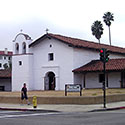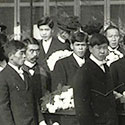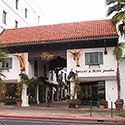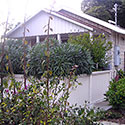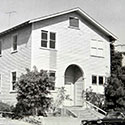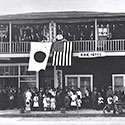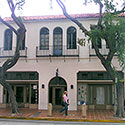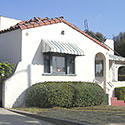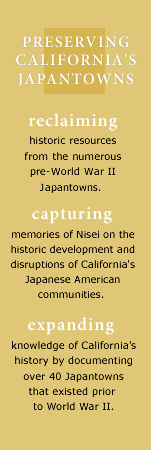 |
Santa BarbaraEfforts by local residents during the 1960s to recreate the 17th-century Spanish Presidio marked the final erasure of Santa Barbara’s Japantown. The 100 block of E. Canon Perdido, now the heart of El Presidio de Santa Barbara State Park, was once the cultural, commercial, social and religious center of Santa Barbara’s Japanese American community. The 1910 census lists just over 200 Nikkei living in the communities of Santa Barbara and Montecito. Many immigrants found work serving residents and visitors to these affluent coastal communities; some lived on estates as domestics and gardeners, while others operated businesses that catered to a primarily non-Nikkei clientele. But a core Nihonmachi grew up around the intersection of E. Canon Perdido and Anacapa Streets and by the 1920s held boarding houses, bathhouses, a cleaners, restaurant, pool hall and grocery store. The offices of the Japanese Association, two Kenjinkai, and Congregational and Buddhist Churches joined them on E. Canon Perdido and served Santa Barbara’s Japanese-American population, which numbered about 500 on the eve of WWII. ›› CLICK TO ENLARGE.
PROFILES
| ||||

El Presidio de Santa Barbara State Park now occupies the core of Santa Barbara's Nihonmachi. This building, which recreates a chapel that last saw worshipers in the 1850s, sits on the former site of the Japanese Buddhist Church. 1941 Nikkei directory listings for this block of E. Canon Perdido include two hotels, a barbershop and bathhouse, midwifery, a grocery and restaurant. As early as the 1920s, Santa Barbara's nearby Chinatown and other downtown blocks were being transformed into a visually unified commercial streetscape designed to recall a mythical Californio past and animated by festivals such as the "Old Spanish Days" celebration. Even prior to WWII forced removal and incarceration, a portion of Santa Barbara's Japantown was lost to federal actions in the mid-1930s when a new Spanish colonial-style U.S. Post Office replaced Japanese businesses along Anacapa Street.
As some Nikkei returned to Nihonmachi after WWII, proprietors of several pre-war businesses resumed operations and were joined by new community members. But by the late 1950s, the community had dwindled. And within ten years, the last remaining structures from Nihonmachi, including the Asakura Hotel complex, the Buddhist Church and Congregational Church, had been demolished. In 1963, the Santa Barbara Trust for Historic Preservation formed to reconstruct the Presidio, the last of four Spanish fortresses built in California, and by 1966 had joined in partnership with California State Parks to manage the new "historic site." As years have passed, the Trust has worked to document the diverse stories associated with this block, and in 1991 hosted a Nihonmachi reunion that drew hundreds of Santa Barbarans.

Santa Barbara's Buddhist Church began in 1913 as a branch of the Guadalupe church. The temple building depicted above was dedicated in 1923 at 131 E. Canon Perdido Street, and within a few years was home to a Mother's Club, a Japanese Language School and Young Men's and Young Women's Buddhist Associations. Santa Barbara's Japanese Congregational Church grew out of English classes offered to Issei by a member of the local First Congregational Church. By 1916, the congregation was established in a building at 117 E. Canon Perdido, a few doors west of the Buddhist Church. While the Christian church had fewer members, it played a similar social, cultural and recreational function for many families. By the 1930s, the churches sponsored popular baseball teams that played throughout the region and as far away as San Jose. They also hosted screenings of Japanese movies; "Everybody would go. We all looked forward to it," recalled Tomichi Muneno, as she described the benshi who narrated the film and took the part of each character.
Both of the churches on E. Canon Perdido served as hostels as Japanese Americans returned from internment camps. The Buddhist church was demolished in 1966 and members relocated to a new building in the southeast portion of town at 1015 E. Montecito Street. The Christian church, renamed Bethany Congregational, moved to 556 N. Hope Street and now serves a multi-ethnic congregation. Photo Courtesy of Santa Barbara Historical Museum.

Japanese funeral processions traditionally began at the place where the deceased lived or worked. This procession commenced at the Tokyo Restaurant, a downtown eatery depicted ca. 1915. Photo Courtesy of Santa Barbara Historical Museum.

One of the first Japanese immigrants to settle in Santa Barbara, Sentaru Asakura brought others from his home prefecture of Kumamoto beginning in 1907. Without the web of family ties from home, prefectural associations were the basis for a tightly knit social and economic network among the families from Kumamoto and another group from Hiroshima. Along with the Fukushimas and Kakimotos, the Asakuras helped to found the Buddhist Church and Kumamoto Kenjinkai within a decade of their arrival. These three families owned much of the land on which Santa Barbara's Nihonmachi stood, and provided community leadership for many years.
The image above depicts the ca. 1908 ceremony marking completion of the Asakura Hotel at 111-1/2 E. Canon Perdido Street. Adjacent properties soon held the Asakura family home, a bathhouse, grocery store and barbershop. With their son Takazumi employed by the War Relocation Authority to help fellow Nikkei resettle in Santa Barbara, the Asakura family were among the few to return to Santa Barbara following forced relocation and incarceration in Gila River camp. By 1965, the Asakura boarding house and the Congregational Church nearby had been demolished to make way for the recreated Presidio State Park; the property is now used as a parking lot. Photo Courtesy of the Santa Barbara Trust for Historic Preservation.

In addition to barbershops, bathhouses, and markets that catered to Japanese immigrants and their children, Nikkei established businesses whose clients drew from Santa Barbara's affluent residents and visitors. Takazumi Asakura, whose parents established the Asakura Hotel on E. Canon Perdido, ran the Arcade Flower Shop, which was listed in the El Paseo Building on State Street in 1941 directories. The El Paseo, constructed in 1922 on a block of Santa Barbara's historic Chinatown, was a showpiece for the wholesale transformation of Santa Barbara's downtown, which was being redesigned to evoke the "golden days" of a Spanish colonial city.
While some Nikkei sold flowers and produce in Santa Barbara shops like the Arcade Florist, others cultivated these crops in small fields scattered throughout the city. During the 1920s, several Nikkei families grew freesias in an area of Santa Barbara called the Mesa, and cultivated truck farms on lots in the southeast part of the city.

Several blocks south of Santa Barbara's Nihonmachi, this building held the Nikkei-owned Empire Dye Works and offices for Santa Barbara's Japanese American Citizen's League before WWII. In the months leading up to US entry into the war, the local JACL worked to assure fellow residents of their loyalty to the United States. For years prior to WWII, Santa Barbara's Japanese community reportedly enjoyed relatively harmonious relations with other residents, particularly some of the local elite who appreciated Japanese art and culture. In 1930, the Japanese Association donated 100 cherry trees to the City to be planted in a public park. Within a few years, a Japanese-American Society, initiated by leaders from the Japanese community, was established and expanded to include Caucasians. The Society held meetings and activities that were frequently covered by the Santa Barbara press. Anticipating increased animosity toward Japanese Americans, the Society held a "Race Relations Program" in 1941 on a local estate with UC professor and artist, Chiura Obata, as the guest of honor. After Pearl Harbor. Santa Barbara JACL President Takazumi Asakura repeatedly stressed the local Nikkei community's patriotism and in January of 1942 pledged to raise $3,000 for defense bonds each month. By May 1st, the entire Japanese American community had been sent to Tulare Assembly Center, and then on to Gila River Relocation camp in Arizona.

Just prior to WWII, this modest bungalow several blocks west of Nihonmachi held the "Gospel Home," a branch office of the Japanese American News, and residential listings for A. Abe and N. Nakagawa. Santa Barbara also had branches for the Los Angeles-based paper, Rafu Shimpo, and the Japan-California Daily.

Pre-WWII directories list two sites for the Toyo Shoe Shop, one at this bungalow about ten blocks east of Nihonmachi, and another that no longer stands on the major commercial thoroughfare of State Street.
